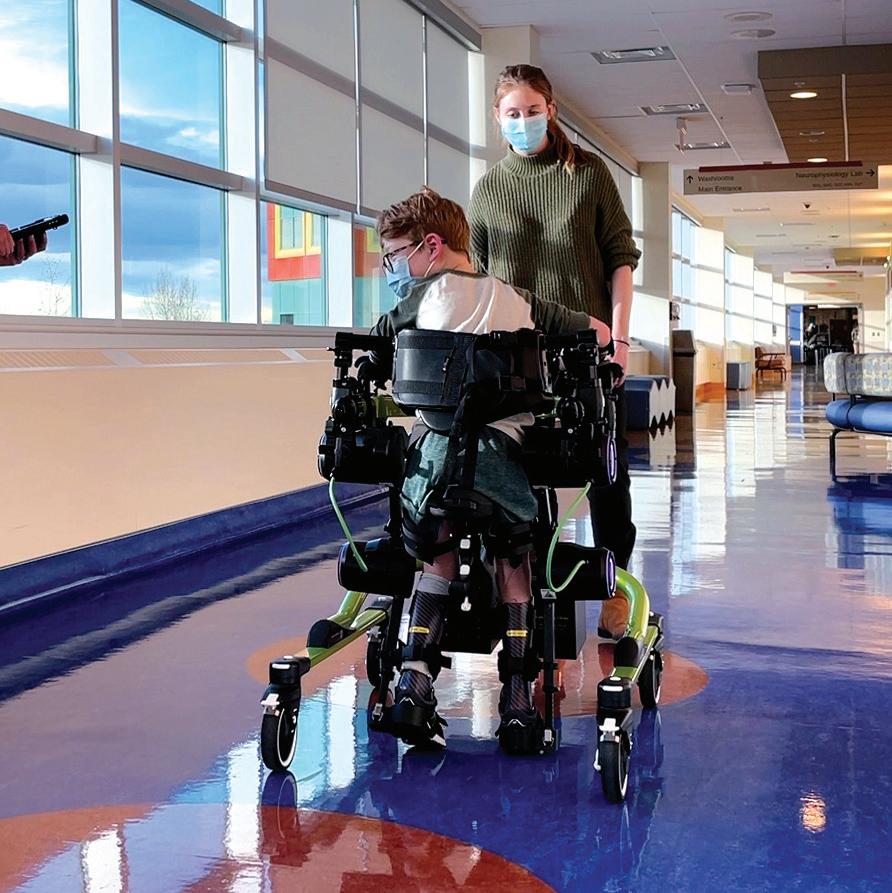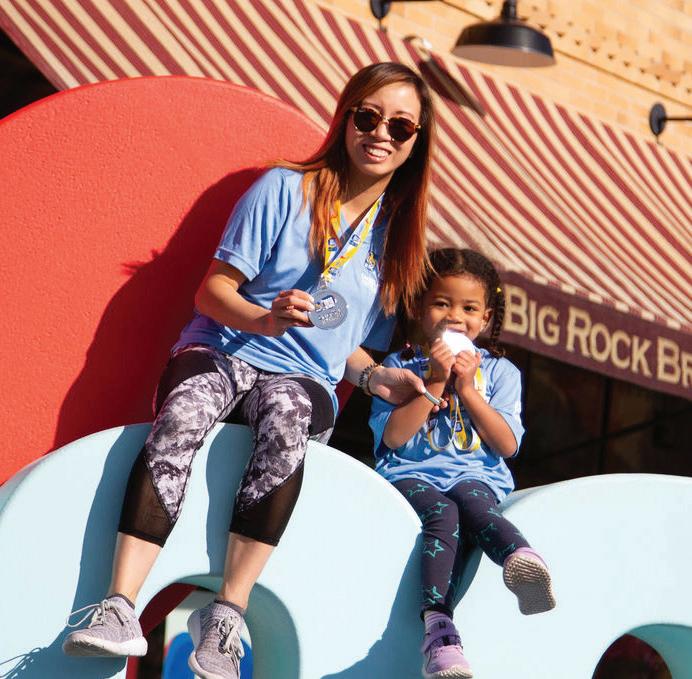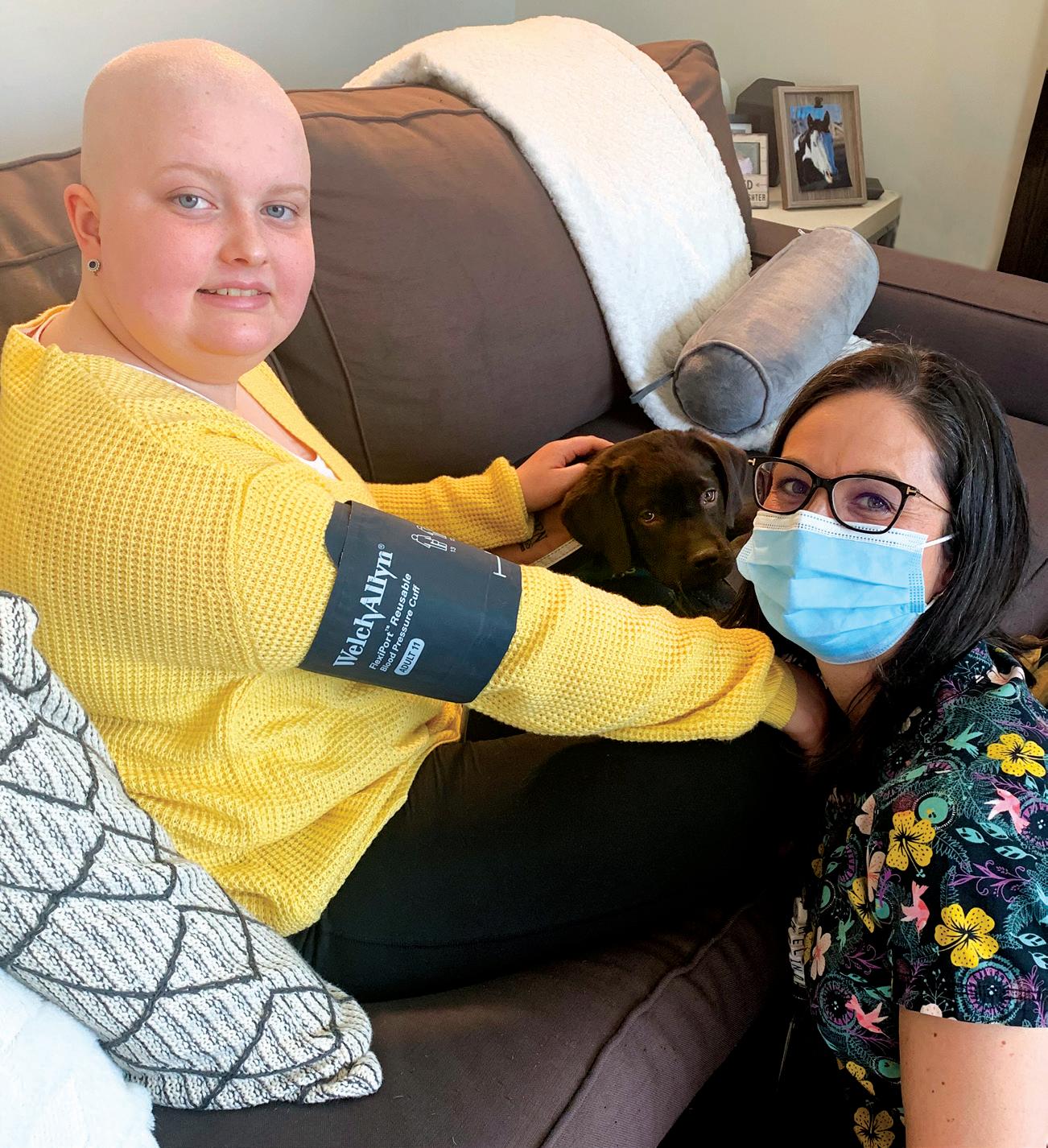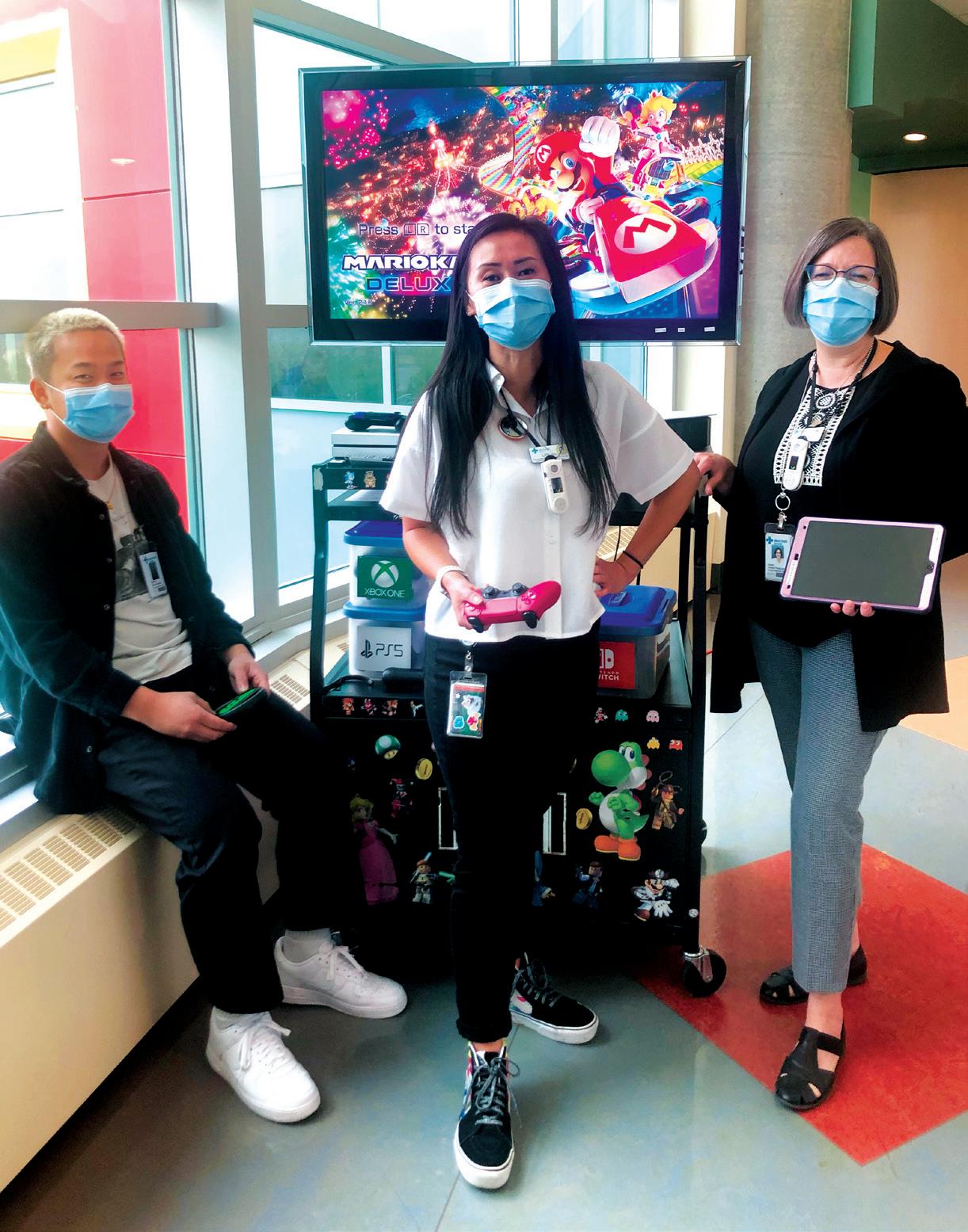






Last fall, eight-year-old Rowan walked with the help of robotic legs and loved every minute of it. Rowan has cerebral palsy, lacks control of his muscles and has used a wheelchair his whole life. At least, that was his reality until last September, when he was able to try new Canadian-made technology called Trexo, the focus of donor-funded clinical research at the Alberta Children’s Hospital.
The Trexo gait trainer is a wearable robotic device that helps children with disabilities and motor impairments experience walking. It works by supporting a child within an adjustable frame while gently moving their legs in a preset custom gait pattern.

“Rowan was thrilled to be moving on his own,” says his mother, Erin Hannigan. “He immediately became more social, talking a mile a minute and wanting to show and tell everyone that he could walk.”
“We are excited to study the impact of robotic assisted walking on children’s health and wellness, including how it affects balance, muscle spasticity, sleep, and other consequences of physical inactivity,” says Dr. Elizabeth Condliffe, a neuroscientist with the Alberta Children’s Hospital Research Institute and Hotchkiss Brain Institute at the University of Calgary.
She and her team are working with dozens of young people at the Alberta Children’s Hospital to examine how using Trexo affects rehabilitation, might help them overcome physical and social barriers, and potentially prevents the onset of chronic medical conditions. Ultimately, her hope is to conduct a multi-centre trial so as many children as possible could benefit from this innovative approach to care.
“They say sitting eight hours a day is bad for your health. Imagine how bad it is for a child spending their entire life in a wheelchair,” says Manmeet Maggu, co-founder of Trexo Robotics. He and his partner were inspired to develop the technology to help children like Maggu’s nephew, who was born with cerebral palsy. Their company received support from the UCeed Child Health and Wellness Fund, a first-in-Canada early-stage investment program made possible by community generosity through the Alberta Children’s Hospital Foundation.
“The feeling of independence was a big confidence booster for Rowan and the workout helped with his eating, digestion and post-surgery rehab,” says Hannigan. “We are so grateful Rowan is part of this Trexo research. Now that he’s had this experience, it makes us hopeful and curious for what other technology advancements will help him in the future.”
UCeed is a University of Calgary initiative that leverages philanthropic support to seed fund, train, mentor and support locally and nationally based startup companies. In partnership with the Alberta Children’s Hospital Foundation, the UCeed Child Health and Wellness Fund was created to get research discoveries that improve children’s health into the marketplace faster, create jobs, and fuel the economy.
“UCeed’s network and expertise in the commercialization of medical devices have helped us navigate the complex challenges that come with any healthcare startup,” says Trexo Robotics co-founder Manmeet Maggu. “We are very fortunate to have UCeed partner with us.”
Being involved with the UCeed program is allowing Trexo Robotics to scale production and reach more families of children with disabilities who wish to walk.
UCeed is part of an innovation ecosystem that includes partners like Innovate Calgary, the Hunter Hub for Entrepreneurial Thinking, Life Sciences Innovation Hub, and Creative Destruction Lab – Rockies. In just four years, Calgary has nearly tripled its number of healthcare startups. The UCeed Child Health initiative is fueling that growth. Since launching in 2020, it has invested in nine companies which, in turn, have already secured more than $17M in follow-on investment.
To learn more,
thanks to everyone celebrating the hospital’s milestone year! We appreciate your incredible support and look forward to investing in the Next 100 together.






Calgary’s first dedicated centre for child and adolescent mental health will be called The Summit: Marian & Jim Sinneave Centre for Youth Resilience — honouring the lead donors for the new facility while reflecting valuable sentiments from the community.

“We are so delighted the Sinneaves were open to letting the centre bear their name,” says Saifa Koonar, President and CEO of the Alberta Children’s Hospital Foundation. “While their initial desire to remain anonymous with their transformational gift speaks to their humility, we’re honoured that they agreed to let us celebrate their unprecedented generosity in this way.”
Marian Sinneave and her late husband Jim’s legacy is their commitment to community well-being by supporting organizations like the Alberta Children’s Hospital.
“With thoughtful intent and compassion, it was important to Marian that this gift be truly transformational,” says Eva Friesen, President & CEO, Calgary Foundation, who helped facilitate the donation. “By undertaking research and providing crucial new services, the Summit will greatly impact the lives of young people in urgent need of mental health care.”
“We are incredibly grateful for the support from the Sinneaves and our entire
community. It shows how much mental health and this centre touch all of our hearts,” says Steph Hancock, a member of the centre’s Youth Advisory Council.
The Youth and Family Advisory Councils, young people with lived experience, Alberta Health Services staff and the public participated in an engagement exercise earlier this year that shaped the other meaningful parts of the centre’s new name.
“We thought it was important that the name of the centre feel welcoming to encourage young people to get the support they need,” says Hancock. “The word ‘summit’ reflects the journey and challenge of navigating mental health. Adding ‘resilience’ also creates a sense of hope for young people, that whatever they are facing can be overcome.”
Construction on the centre is expected to wrap up by the end of the year with doors opening in early 2023. The Summit will provide three new services for kids, teens and their families through the Owerko Family Walk In Services, on-site intensive therapy and the Ptarmigan Day Hospital. In partnership with Alberta Health Services and the University of Calgary, it will also be one of the most research-intensive community-based mental health facilities for young people in Canada.
To learn how you can support mental health initiatives for children, teens and young adults, please visit buildthemup.ca.
They say there’s no place like home. Few people understand that better than 15-year-old Lauren Gamble and her family.
This time last year, in the thick of her cancer treatments, all Lauren wanted was to sleep in her own bed, watch TV on her couch and hang out with her family and friends. If she lived anywhere else in the country, that would have been out of the question.
Three months earlier, Lauren and her family found out the pain in her leg was being caused by a tumour the size of a brick. She had osteosarcoma – bone cancer.
“Hearing that your active, athletic, healthy child has bone cancer is absolutely earth shattering,” says her mom, Lindsay. “Those words changed our lives forever.”
Lauren’s dedicated team of oncologists at the Alberta Children’s Hospital began treating her immediately with the goal to save her life and her leg. They put Lauren on an
intensive course of chemotherapy aiming to first shrink the tumour then remove the mass through surgery.
Despite having the best specialists caring for her, the harsh treatments left Lauren feeling nauseous, exhausted and disheartened. To make matters worse, giving up her favourite activities – dance and horseback riding – and missing time with friends, family and her beloved dog during lengthy hospital stays took a huge toll on her spirit.
“There were times when I didn’t know if I could handle more treatment. Thankfully, Hospital at Home was my saving grace,” says Lauren.
Thanks to generous community support of this first-in-Canada program, Lauren could receive chemotherapy, intravenous medications and supportive therapy in the comfort of her living room.

Because of Hospital at Home, Lauren was able to spend 50 fewer nights in hospital than she would have had to without
– Lindsay, Lauren’s Mom
Lauren receives care from her Hospital at Home nurse, Melinda.
Hospital at Home gave Lauren the freedom to live her life as a typical teenager and gave her the mental strength she needed to push through the harsh treatments.”
the program. Carrying her IV bag in her backpack, Lauren could leave her house to hang out with friends who wouldn’t have been able to visit her in hospital. She was able to go Christmas shopping, and even got her learner’s license!
“Hospital at Home gave Lauren the freedom to live her life as a typical teenager and gave her the mental strength she needed to push through the harsh treatments,” says Lindsay. “It allowed us to enjoy moments as a family that wouldn’t have been possible had she been in hospital. Those are memories we will cherish forever.”
Last November, surgeons skillfully removed Lauren’s tumour and reconstructed her leg in an 18-hour operation. Rather than spending Christmas in hospital, Lauren was gratefully able to spend the holidays at home.
Following six more months of chemotherapy, her cancer was in remission. Unfortunately, just as Lauren was setting her sights on going back to school and her beloved activities this fall, the cancer returned.

Though her road ahead is uncertain, Lauren and her family believe programs like Hospital at Home are needed now more than ever.
“Programs like Hospital at Home are so crucial for kids like Lauren so that even while going through a medical journey, they can still enjoy their childhoods and treasured time with loved ones,” says Lindsay. “We are grateful to generous people in our community who make programs like Hospital at Home possible.”
While specialists at the Alberta Children’s Hospital provide world-class care, the unfortunate reality is that current therapies can be incredibly taxing – both physically and mentally – on children.
By making a gift, you can help ease some of that stress and hardship and help more young people like Lauren receive the same life-saving, family centred care.
To donate, scan the QR code below, visit childrenshospital.ab.ca/hope or use the enclosed postage-paid return envelope to mail in your support.
Thanks to your generous support, life-saving and life-changing programs and initiatives are available for 100,000 children every year at the Alberta Children’s Hospital. Here is a snapshot of the difference you made for them and their families.
When it comes to seizure disorders, each child’s case is unique, meaning each treatment path must be, too. Through the new Alberta Children’s Epilepsy Program, a highly skilled team of experts is building a centre of excellence in epilepsy care for Western Canada at the Alberta Children’s Hospital.
Thanks to community support, the team is creating a new clinical trials unit to explore new treatments for children whose epilepsy does not respond to current medications. Kids in our community now have access to seven new trials.
As the pandemic persists and the cost of daily living rises with inflation, families with sick and injured children are relying on support from the Special Children’s Fund more than ever.
Thanks to you, last year 2,700 requests were fulfilled, providing a record $241,000 in funding for necessities like accommodation, food, gas, transportation, parking, medications and specialized medical equipment for children whose families would otherwise lack the means to afford them.
For children with life-limiting or medically complex conditions, Rotary Flames House is a home away from home. This year, 168 children benefitted from a respite stay, enjoying special programming in the care of knowledgeable, loving staff while their parents took time to recharge. Children could also participate in other fun activities virtually this past year, including a Halloween party and visit to the Calgary Zoo.
As Alberta’s only pediatric hospice, Rotary Flames House is also a place of comfort for parents treasuring final moments with their child through compassionate end-of-life care. As well, more than 250 families benefitted from grief support this year, connecting with counsellors and other families coping with unimaginable loss.
A special training program called CanREACH helps primary care providers such as family physicians and pediatricians better recognize and treat mental health disorders in children and youth. This reduces the need for families to wait or travel to see specialists.
Thanks to your support, nearly 400 care providers across Alberta have benefitted from the training over the past two years, which translates to as many as 90,000 young people and families with access to better mental health care close to home.
Acute at Home enables children in mental health crises to receive care in the comfort of their own homes from specially trained therapists, social workers and nurses. Experts deliver intensive mental health care for children and teens — in person, by video or phone — using treatments tailored to their needs. They also act as liaisons and advocates for children at their schools.
Thanks to the support of community and in partnership with Wood’s Homes, 1,435 young people received care through Acute at Home.
The Alberta Children’s Hospital Research Institute (ACHRI) unites more than 1,000 researchers, scientists and clinicians who are focused on the lifelong health and wellbeing of kids and families. Your support for the ACHRI team and this partnership among the University of Calgary, Alberta Health Services and the Alberta Children’s Hospital Foundation, enables the best and brightest to solve some of the most pressing health issues today.
117
families were provided a private suite in the Colonel Harland Sanders Family Centre within the hospital so they could stay close to their child.
1,700
visits with patients through Therapeutic Arts programs, including Music and Art Therapy as well as SPARKLE the Therapeutic Clown. 408
children received mental health peer support either in person, by phone or video.
2,680
frontline healthcare workers and students benefitted from real-time emergency scenario training through the KidSIM program last year.
Thanks to you, kids and families benefitted from:
TOP FUNDRAISER Age 9 and under Blakley Krause

Age 10 and older Paige Krause
TOP FUNDRAISING GROUP
Sauce Hockey
TOP FUNDRAISING
SCHOOL
George McDougall
High School
Jayda Bharmal
Bianca Jiwa
Rhaine Marquardt
Carter Simpson
Zachary Walker
While some sold lemonade or donated their birthday money, others organized head shaves, bike-a-thons and bottle drives. Whichever way they chose to fundraise, young philanthropists in our community all had the same goal in mind — to help sick and injured kids at the Alberta Children’s Hospital.
Through the Kids Helping Kids program, hundreds of young people raised an incredible $394,231 this past year in support of state-of-the-art equipment, family centred programs and groundbreaking research at the Alberta Children’s Hospital.
For their efforts raising an impressive $30,000 and counting, sisters 12-year-old Paige Krause and her 10-year-old sister, Blakley each won a top award at the 2022 Kids Helping Kids Celebration in September.


They spent their past few summers collecting bottles around Okotoks to raise $1,000 for the hospital while asking local companies to match that with a $1,000 gift.
The girls chose to give back because they, themselves, have both relied on the care at the hospital. When she was younger, Paige spent time at the hospital being treated for an infection, and Blakley currently sees specialists at the endocrine clinic.
“Everybody who walks into that hospital is made to feel like family,” says Paige. “All of the staff are really kind and generous and really want to help the kids. The hospital is made to look like a Lego building and it helps the kids feel safe and at home. If we didn’t have the Alberta Children’s Hospital, I would have been very sick and I know that a lot of other kids would have been too.”
Kelsey Krause, Blakley’s mom and Paige’s step-mom, says she is so proud of the girls for not only dreaming up the idea on their own, but for the reason they wanted to help.
“They both feel a lot of gratitude to the Alberta Children’s Hospital, and they know not everyone is as fortunate to have a world-class hospital so close to home,” Kelsey says. “Because they are communityminded, they decided that is how they wanted to give back.”
Feel inspired to be part of Kids Helping Kids? Even the smallest hands can make the biggest difference. Learn more at childrenshospital.ab.ca/khk.
Distraction comes in many forms. For some kids, it’s a colouring book, paintbrush or a plushie. Others might find it behind the wheel in a game of Mario Kart.
That’s where the Child and YoutH Interactive Media Program (CHIMP) comes into play. CHIMP supports the psychosocial needs of kids using video games, computers, iPads, cameras, and other STEAM (Science, Technology, Engineering, Arts, Math) devices in therapeutic ways to help them cope with the challenges of illness or injury. The program is entirely donor funded and plays a huge role in the hospital’s distraction strategy to soothe jitters, put kids at ease, as well as educate them on how to use technology safely.
Daniel Trujnikov was 11 when he was diagnosed with Acute Lymphoblastic Leukemia. The aggressive chemotherapy plan was hard on him. He suffered an allergic reaction to the drug early on and he could not stomach the thought of another IV treatment, though he would still need many.
CHIMP coordinator Linh Lam (more affectionately known as “the video game lady” among kids) and members of the CHIMP team would visit Daniel to take his mind off the treatment.
“He was extremely anxious, but Linh would come with the big video game cart and they would play different games while he was administered the drug, and it helped a lot,” says Daniel’s mom, Amina.
By the time Daniel finished his last treatment, he was a pro with the needles and with his favourite games, leaving a cheeky note for Linh after he was done.
“I have many great memories with you and you made my hospital visits way better and happier. Thank you for being the best. PS: I’m still better at Minecraft than you.”
For “the video game lady,” it’s interactions like that which make hers the best job in the world.
“We’re not there to poke or prod them, we’re there to give them a break and have some fun. It’s so meaningful to all of us, and we are so grateful for the community support that makes it all possible,” says Lam.
A small but mighty team of three along with volunteers, CHIMP supports kids in the entire hospital, which includes inpatients on all units, ambulatory clinics/areas, as well as at the Gordon Townsend School and Rotary Flames House.
Along with providing access to developmentally appropriate games and electronics, the team works with patients who are interested in photography, coding, even robotics. They have also seen great success using virtual reality headsets.
Did you know, you can play games and help kids? Extra Life unites thousands of gamers around the world in support of their local children’s hospital. Since 2011, Extra Life has raised more than $14.5 million for sick and injured kids in Canada. Learn more at extralifeyyc.com

Kick off your holiday season in support of the kids! Everyone is invited to check out the amazing online auction items or buy a raffle ticket for a fabulous private jet trip for eight to Vegas! Bid or buy by December 2.
